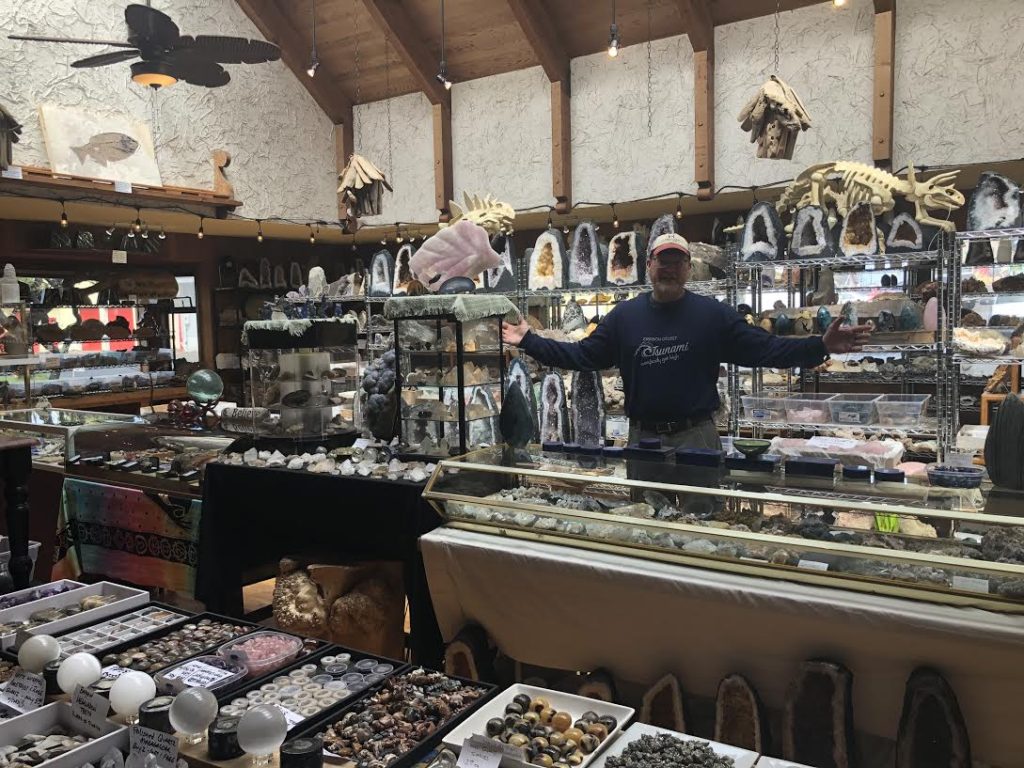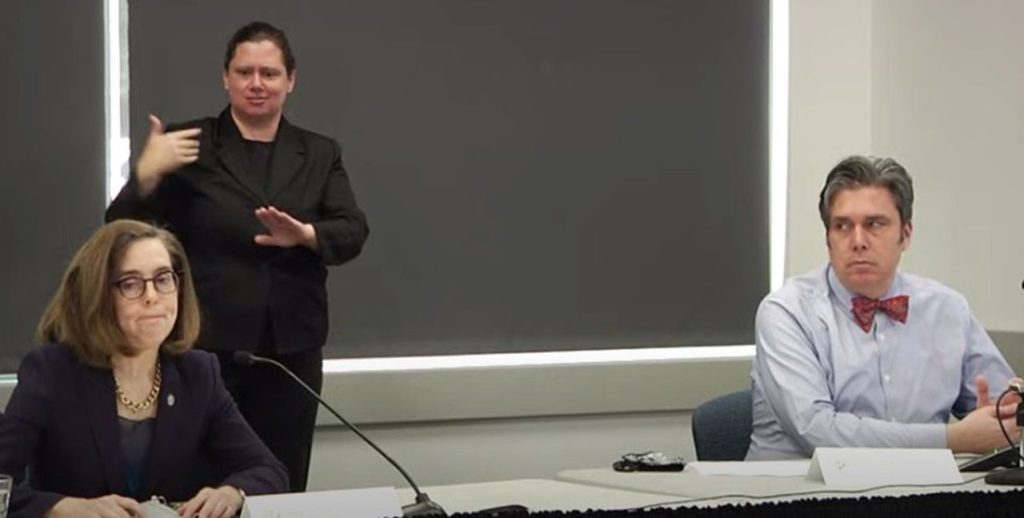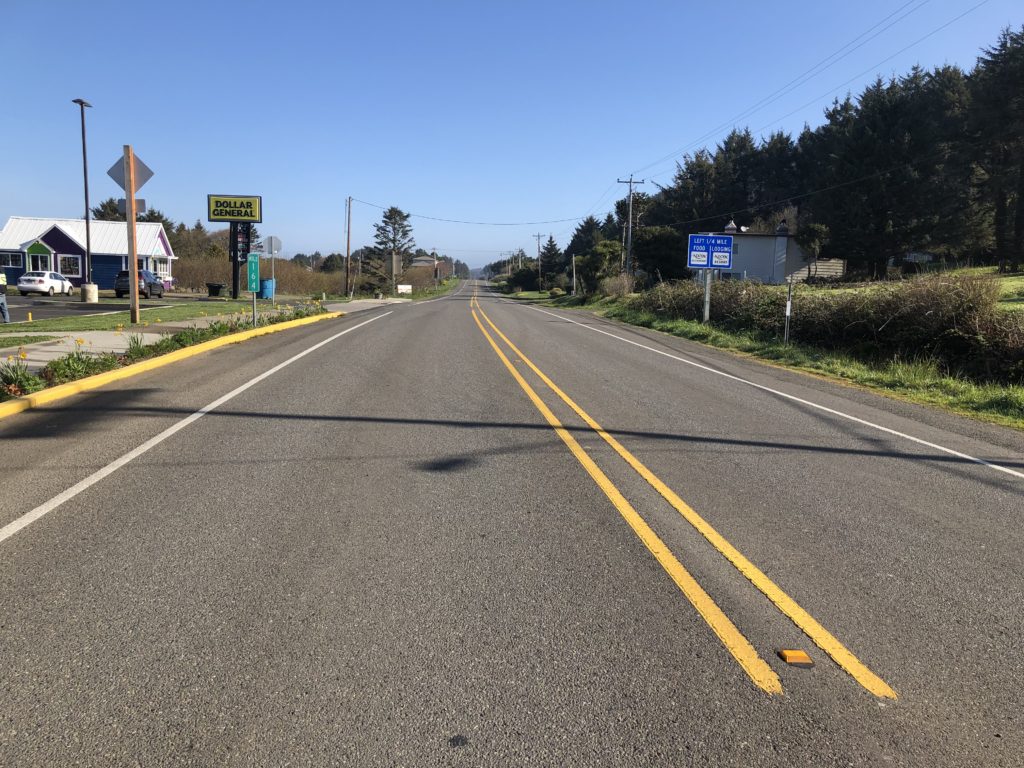
By GARY A. WARNER/Oregon Capital Bureau
and QUINTON SMITH/YachatsNews.com
Lincoln County residents can now eat in a restaurant, get a haircut, buy books or art and go to the gym after eight weeks of state restrictions because of the coronavirus pandemic.
Gov. Kate Brown announced Thursday that 31 of Oregon’s 36 counties – including Lincoln County — can take the first step Friday to lift emergency limits on activity in place since March 23.
During a phone-in press conference, Brown said she realized that the decision to reopen some but not all counties would be seen as too little by residents who want to accelerate an economic rebound and too much by those concerned that it could lead to another spike in infections.
“But my job is to make hard decisions, even when they are unpopular,” Brown said. “When it comes to the health and safety of Oregonians, the buck stops here.”
By the end of the day, the partial re-opening was approved for 31 of 36 counties. Those getting the green light included all counties along the Oregon coast, all counties east of the Cascades, and counties in Southern Oregon. In the Willamette Valley, the populous counties of Lane, Linn, and Benton were among those given permission to re-open.
While more than two-thirds of Oregon’s 36 counties qualified to reopen, about half of Oregon’s 4.2 million residents live in counties not covered by Thursday’s decisions.
The state’s three largest counties — Multnomah, Washington and Clackamas — have not filed requests, saying they were not yet prepared to reopen. They represent nearly 1.8 million residents.
Marion and Polk counties, with a combined population of about 417,000, had their applications rejected because of concerns over high infection rates.
Among Oregon’s five largest counties, only one — Lane County at No. 5, which includes the city of Eugene, can re-open.
Brown’s approval was one of three developments concerning COVID-19 restrictions Thursday.
- Although the state approved Lincoln County’s reopening proposal, county commissioners still had to put a date on it to allow restaurants and personal services to reopen Friday, if they wanted. They did that five hours later – sending some barbers scrambling to take appointments or restaurants to move tables and prepare food.
- The announcement had nothing to do with a directive earlier this week that many retail shops across Oregon – regardless of their individual county plans — could open Friday. Many will, including a handful in Yachats.
- And, locally, Brown’s approval of county plans and reopening retail had nothing to do with closing of lodging in Lincoln County to recreational visitors, which was only a local restriction. County commissioners and six of the seven cities held a 2 1/2-hour meeting Thursday afternoon to approve a piecemeal reopening of motels, vacation rentals, RV parks and campgrounds ranging from May 22 to June 1. (See separate story)
- Lincoln County’s reopening Friday also triggered Oregon State Parks and Recreation to begin taking down barriers to its 12 day use areas from Newport to Yachats. (See separate story.)

Balancing public health and the economy
Brown said the moves Thursday were an attempt to balance the sometimes competing goals of public health and economic revival from a crisis that has put nearly 400,000 Oregonians out of work.
“The shared goals of good public health and a strong economy are intimately connected,” she said. “It’s not an either/or scenario. As we reopen parts of our economy, we know and expect that there may be an uptick in new coronavirus cases.”
Brown said there will be no assured path to both ensuring public health and allowing the economy to recover in the foreseeable future. She likened the moves announced Thursday as the equivalent of stepping out on ice without truly knowing how thick or thin it might be underfoot.
“Reopening any part of our state comes with risk,” Brown said. “This virus is still very dangerous. Until there is a reliable treatment or a vaccine, unfortunately, we will not be able to go back to life as we knew it.”
But the fact that large swaths of the most populous areas won’t see a change has Brown and state officials worried that residents in those areas could travel to areas such as the Oregon coast, Deschutes County and cities like Eugene where they can enjoy relative freedom to eat, drink and socialize. That could expose the open counties to outside infection from counties that remain closed.
“We hope that people will stay close to home,” Brown said.
Oregon has recorded over 3,000 positive cases and 137 deaths during the coronavirus pandemic. The state has recorded among the lowest per capita infections and deaths in the nation.
In Yachats, some will open, some not
The reaction by retail shops and restaurants in Yachats depended on the personal situations of owners, whether they felt comfortable opening, or how quickly they could prepare properly for restrictions on serving customers.
Marc Taylor, owner of Styx, Stones n’ Bones in downtown had spent the past week reorganizing his large shop to create aisles to make sure customers browsing tons of rocks and minerals could stay six feet apart.
“I probably, by rearranging, actually improved the store,” Taylor said Thursday. “The whole point to me is to allow me to choose whether to open or my customers whether to choose to come.”
Mary Crook, co-owner of Books and More in the C&K Plaza plans to open at 10 a.m. Friday, with plenty of cleaner, hand sanitizer and a limit of four customers in the store at any one time.
Crook’s bookstore partner, Yvonne Erickson, won’t reopen her adjacent Just Local craft store for at least another few weeks, she said.
The Laughing Crab Gallery will reopen at 10:30 Friday, co-owner Kim McLaughlin said Thursday as she rearranged space inside the shop.
“It’s going to be a process,” she said. “I don’t think there will be a lot of people, so that gives us some time to adjust.”
Restaurants were a mixed bag.
Luna Sea Fish House will open for dine-in meals Friday, said owner Robert Anthony. “We’re running around trying to get ready,” he said.
The Drift Inn restaurant will open Saturday morning for breakfast, said owner Linda Hetzler, and will have its spacious back patio ready for guests. Music resumes Saturday night.

Yachats Brewing + Farmstore plans to continue to only offer takeout beer and food Friday through Sunday for the next few weeks as it prepares to more fully reopen under new dining restrictions.
“We’ll eventually reopen in-house dining but it will be a different look,” said owner Nathan Bernard.
The Sea Note restaurant and bar plans to reopen May 23, said co-owner Brian Dimiceli, the same time as its sister restaurant, the Salty Dawg in Waldport, resumes inside dining.
“We’re going to get everything up to snuff,” Dimiceli said. “But you’re in a Catch 22 situation as to whether to open. What happens if no one comes? What happens if the coronavirus sweeps through the county and they close us down again?”
What counties have to do
Oregon counties were invited last week to submit plans to have some of the restrictions under Brown’s March closure orders lifted. They had to meet a list of standards set by the Oregon Health Authority, including evidence that the county could test for COVID-19 infections and had the staff available to trace the contacts of anyone with a positive result.
Each county also had to account for its ability to isolate positive cases, including homeless people who did not have the resources to do so on their own. Counties had to show they could provide medical care and hospital space if there was another outbreak.
Lincoln County has had just seven confirmed COVID-19 cases and is one of 13 Oregon counties with seven or fewer cases. But local officials worry that an influx of tourists – despite the governor’s admonition limit travel to no more than 50 miles – will bring more cases.
The next step will be to see if the loosened restrictions will lead to a spike in cases. In three weeks, each county’s infection statistics will be reviewed, including hospital use, ability to trace cases, and adherence to social distancing guidelines.
If successful, Lincoln County would be eligible on June 4 to move on to less restrictive controls, which have not fully been detailed yet. Larger group gatherings are one of the most likely results, as well as allowing more visits to elder care facilities, which have been a major infection point.

Brown encouraged residents to retain the resolve and patience most have shown so far, so that the isolation that led to a less-than-expected impact on the state doesn’t go to waste with a resurgence.
She said she understood the frustrations of residents who have had to deal with restrictions on their lives, closed businesses and lost jobs.
“I know this is hard,” she said.
Brown said she hopes that if infection trends remain in check, schools might be able to reopen in time for the fall semester.
“Education is the game changer for families across the state,” Brown said.
But it’s too early to make a call on that and many other aspects of public life.
“We are going to have to be more nimble and flexible,” she said. “It’s not going to be like last fall.”

Brown urges Portlanders to stay home
While Oregon’s three largest counties work on their reopening plans Brown said her stay-home order still applies to residents in the Portland area and she discouraged them from traveling.
“We are asking folks in metro area to be thoughtful of their fellow Oregonians, and to stay home and limit their travel to essential needs,” she said. “We obviously don’t want to overwhelm the rest of Oregon by traveling outside the metro area.”
If there is an increase in infections, Brown said the restrictions could be reinstated. However, she declined to say how the restrictions would be imposed and enforced.
“If we can’t beat back the virus, we will implement restrictions,” she said.
As for those who openly flout the rules, Brown said she is hoping for community cooperation in keeping Oregon safe.
“I know there are a few outliers, but they do not reflect the majority,” Brown said.
Brown said that outside enforcement was much less effective than what had worked so far: community cooperation.
“We are all in this together,” Brown said. “We need to be thoughtful and considerate of our neighbors.”


